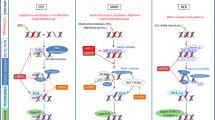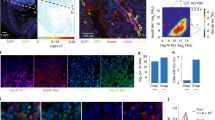Abstract
Mammalian cells respond to stress by accumulating or activating a set of highly conserved proteins known as heat-shock proteins (HSPs). Several of these proteins interfere negatively with apoptosis. We show that the small HSP known as Hsp27 inhibits cytochrome-c-mediated activation of caspases in the cytosol. Hsp27 does not interfere with granzyme-B-induced activation of caspases, nor with apoptosis-inducing factor-mediated, caspase-independent, nuclear changes. Hsp27 binds to cytochrome c released from the mitochondria to the cytosol and prevents cytochrome-c-mediated interaction of Apaf-1 with procaspase-9. Thus, Hsp27 interferes specifically with the mitochondrial pathway of caspase-dependent cell death.
This is a preview of subscription content, access via your institution
Access options
Subscribe to this journal
Receive 12 print issues and online access
$209.00 per year
only $17.42 per issue
Buy this article
- Purchase on Springer Link
- Instant access to full article PDF
Prices may be subject to local taxes which are calculated during checkout







Similar content being viewed by others
References
Nicholson, D. W. & Thornberry, N. A. Caspases: killer proteases. Trends Biochem. Sci. 22, 299–306 (1997).
Thornberry, N. A. & Lazebnik, Y. Caspases: enemies within. Science 281, 1312– 1316 (1998).
Kroemer, G., Dallaporta, B. & Resche-Rigon, M. The mitochondrial death/life regulator in apoptosis and necrosis. Annu. Rev. Physiol. 60, 619 –642 (1998).
Shimizu, S., Narita, M. & Tsujimoto, Y. Bcl-2 family proteins regulate the release of apoptogenic cytochrome c by the mitochondrial channel VDAC. Nature 399, 483–487 (1999).
Marzo, I. et al. Bax and adenine nucleotide translocator cooperate in the mitochondrial control of apoptosis. Science 281, 2027– 2031 (1998).
Reed, J. C. Cytochrome c: can't live with it-can't live without it. Cell 91, 559–562 (1997).
Li, P. et al. Cytochrome c and dATP-dependent formation of Apaf-1/caspase-9 complex initiates an apoptotic protease cascade. Cell 91, 479–489 (1997).
Green, D. R. Apoptotic pathways: the road to ruin. Cell 94, 695–698 (1998).
Ghayur, T. et al. Proteolytic activation of protein kinase C delta by an ICE/CED 3-like protease induces characteristics of apoptosis. J. Exp. Med. 184, 2399–2404 (1996).
Liu, X., Zou, C., Slaughter, C. & Xang, X. DFF, a heterodimeric protein that functions downstream of caspase-3 to trigger DNA fragmentation during apoptosis. Cell 89, 175– 184 (1997).
Eymin, B. et al. Caspase-induced proteolysis of the cyclin-dependent kinase inhibitor p 27kip1 mediates its anti-apoptotic activity. Oncogene 18, 4839–4847 (1999).
Susin, S. A. et al. Molecular characterization of mitochondrial apoptosis-inducing factor. Nature 397, 441– 446 (1999).
Susin, S. A. et al. Mitochondrial release of caspase-2 and -9 during the apoptotic process. J. Exp. Med. 189, 381– 394 (1999).
Parsell, D. A. & Lindquist, S. The function of heat-shock proteins in stress tolerance: degradation and reactivation of damaged proteins. Annu. Rev. Genet. 27, 437–496 (1993).
Arrigo, A. P. & Landry, J. In Heat-shock Proteins: Structure, Function and Regulation. (eds Morimoto, R. I., Tissière, A. & Georgopoulos, C.) 335–373 (Cold Spring Harbor Laboratory Press, Cold Spring Harbor, New York, 1994).
Spector, N. L. et al. Growth arrest of human B lymphocytes is accompanied by induction of the low molecular weight mammalian heat shock protein (Hsp 28). J. Immunol. 148, 1668–1673 (1992).
Tetu, B., Lacasse, B., Bouchard, H. L., Lagace, R., Huot, J. & Landry, J. Prognostic influence of HSP-27 expression in malignant fibrous histiocytoma: a clinicopathological and immunohistochemical study . Cancer Res. 52, 2325– 2328 (1992).
Garrido, C. et al. Heat shock protein 27 enhances the tumorigenicity of immunogenic rat colon carcinoma cell clones. Cancer Res. 58, 5495–5499 (1998).
Mehlen, P. et al. Analysis of the resistance to heat and hydrogen peroxide stresses in COS cells transiently expressing wild type or deletion mutants of the Drosophila 27-kDa heat-shock protein. Eur. J. Biochem. 215, 277–284 (1993).
Mehlen, P., Schulze-Osthoff, K. & Arrigo, A.P. Small stress proteins as novel regulators of apoptosis. Heat shock protein 27 blocks Fas/APO-1- and staurosporine-induced cell death . J. Biol. Chem. 271, 16510– 16514 (1996).
Huot, J., Roy, G., Lambert, H., Chretien, P. & Landry, J. Increased survival after treatments with anticancer agents of Chinese hamster cells expressing the human Mr 27,000 heat shock protein. Cancer Res. 51, 5245– 5252 (1991).
Oesterreich, S., Weng, C. N., Qiu, M., Hilsenbeck, S. G., Osborne, C. K. & Fuqua, S. A. The small heat shock protein hsp27 is correlated with growth and drug resistance in human breast cancer cell lines. Cancer Res. 53, 4443–4448 (1993).
Garrido, C. et al. Inconstant association between 27-kDa heat-shock protein (Hsp27) content and doxorubicin resistance in human colon cancer cells. The doxorubicin-protecting effect of Hsp27. Eur. J. Biochem. 237, 653 –659 (1996).
Garrido, C., Ottavi, P., Fromentin, A., Hammann, A., Arrigo, A. P., Chauffert, B. & Mehlen, P. Hsp27 as a mediator of confluence-dependent resistance to cell death induced by anticancer drugs. Cancer Res. 57, 2661 –2667 (1997).
Mehlen, P., Kretz-Remy, C., Preville, X. & Arrigo, A. P. Human hsp27, Drosophila hsp27 and human alphaB-crystallin expression-mediated increase in glutathione is essential for the protective activity of these proteins against TNFalpha-induced cell death. EMBO J. 15, 2695–2706 (1996).
Rogalla, T. et al. Regulation of Hsp27 oligomerization, chaperone function, and protective activity against oxidative stress/tumor necrosis factor alpha by phosphorylation . J. Biol. Chem. 274, 18947– 18956 (1999).
Garrido, C., Bruey, J. M., Fromentin, A., Hammann, A., Arrigo, A. P. & Solary, E. Hsp27 inhibits cytochrome c-dependent activation of procaspase-9. FASEB J. 13, 2061– 2070 (1999).
Medema, J. P. et al. Cleavage of FLICE (caspase-8) by granzyme B during cytotoxic T lymphocyte-induced apoptosis. Eur. J. Immunol. 27, 3492– 3498 (1997).
Van de Craen, M. et al. Cleavage of caspase family members by granzyme B: a comparative study in vitro. Eur. J. Immunol. 27, 1296 –1299 (1997).
Atkinson, E. A. et al. Cytotoxic T lymphocyte-assisted suicide. Caspase 3 activation is primarily the result of the direct action of granzyme B. J. Biol. Chem. 273, 21261–21266 (1998).
Hennig, B. & Neupert, W. Biogenesis of cytochrome c in Neurospora crassa. Methods Enzymol. 97, 261–274 (1983).
Zavialov, A. et al. The effect of the intersubunit disulfide bond on the structural and functional properties of the small heat shock protein Hsp 25. Int. J. Biol. Macromol. 22, 163–73 (1998).
Xanthoudakis, S. et al. Hsp 60 accelerates the maturation of pro-caspase-3 by upstream activator proteases during apoptosis. EMBO J. 18, 2049–2056 (1999).
Samali, A., Cai, J., Zhivotovsky, B., Jones, D. P. & Orrenius, S. Presence of a pre-apoptotic complex of pro-caspase-3, Hsp 60 and Hsp 10 in the mitochondrial fraction of jurkat cells. EMBO J. 18, 2040–2048 ( 1999).
Jäättela, M., Wissing, D., Kokholm, K., Kallunki, T. & Egeblad, M. Hsp70 exerts its anti-apoptotic function downstream of caspase-3-like proteases. EMBO J. 17, 6124–6134 (1998).
Stuart, J. K. et al. Characterization of interactions between the anti-apoptotic protein BAG- 1 and Hsc70 molecular chaperones. J. Biol. Chem. 273, 22506–22514 (1998).
Konishi, H. et al. Activation of protein kinase B (Akt/RAC-protein kinase) by cellular stress and its association with heat shock protein Hsp27. FEBS Lett. 410, 493–498 (1997).
Cardone, M. H., Roy, N., Stennicke, H. R., Salvesen, G. S., Franke, T. F., Stanbridge, E., Frisch, S. & Reed, J. C. Regulation of cell death protease caspase-9 by phosphorylation. Science 282, 1318–1321 (1998).
Kennedy, S. G., Kandel, E. S., Cross, T. K. & Hay, N. Akt/protein kinase B inhibits cell death by preventing the release of cytochrome c from mitochondria. Mol. Cell. Biol. 19, 5800– 5810 (1999).
Qin, H., Srinivasula, S. M., Wu, G., Fernandes-Alnemri, T., Alnemri, E. S. & Shi, Y. Structural basis of procaspase-9 recruitment by the apoptotic protease-activating factor 1. Nature 399, 549–557 (1999).
Hu, Y., Benedict, M. A., Ding, L. & Nunez, G. Role of cytochrome c and dATP/ATP hydrolysis in Apaf-1-mediated caspase- 9 activation and apoptosis. EMBO J. 18, 3586 –3595 (1999).
Slee, E. A. et al. Ordering the cytochrome c-initiated caspase cascade: hierarchical activation of caspases-2, -3, -6, -7, -8, and -10 in a caspase-9- dependent manner. J. Cell. Biol. 144, 281– 292 (1999).
Deveraux, Q. L. et al. IAPs block apoptotic events induced by caspase-8 and cytochrome c by direct inhibition of distinct caspases. EMBO J. 17, 2215–2223 (1998).
Hu, Y., Benedict, M. A., Wu, D., Inohara, N., & Nunez, G. Bcl-XL interacts with Apaf-1 and inhibits Apaf-1-dependent caspase-9 activation. Proc. Natl Acad. Sci.USA 95, 4386–4391 (1998).
De Maria, R. et al. Negative regulation of erythropoiesis by caspase-mediated cleavage of GATA-1. Nature 401, 489– 493 (1999).
Zheng, T. S., Hunot, S., Kuida, K. & Flavell, R. A. Caspases knockouts: matters of life and death. Cell Death Diff. 6, 1043–1053 (1999).
Thor, A. et al. Stress response protein (hsp-27) determination in primary human breast carcinomas: clinical, histologic, and prognostic correlations. J. Natl Cancer Inst. 83, 170–178 (1991).
Love, S. & King, R. J. A 27 kDa heat shock protein that has anomalous prognostic powers in early and advanced breast cancer. Br. J. Cancer 69, 743–748 (1994).
Martin, F., Caignard, A., Jeannin, J.F., Leclerc, A. & Martin, M. Selection by trypsin of two sublines of rat colon cancer cells forming progressive or regressive tumors. Int. J. Cancer 36, 373–377 (1985).
Acknowledgements
The authors wish to thank Elisabeth Bates, Olivier Sordet and Cédric Rébé for technical help, and Alena Pance and Kathryn Nason-Burchenal for helpful advices. This work was supported by grants from INSERM, Conseil Régional de Bourgogne, ARC (6515 and 5204), Comités de Côte d'Or, Saône et Loire, Nièvre de la Ligue Nationale Contre le Cancer et ARERS (E.S.), as well as special grants from the Ligue Nationale contre le Cancer (G.K. and E.S.).
Author information
Authors and Affiliations
Corresponding author
Rights and permissions
About this article
Cite this article
Bruey, JM., Ducasse, C., Bonniaud, P. et al. Hsp27 negatively regulates cell death by interacting with cytochrome c. Nat Cell Biol 2, 645–652 (2000). https://doi.org/10.1038/35023595
Received:
Revised:
Accepted:
Published:
Issue Date:
DOI: https://doi.org/10.1038/35023595
This article is cited by
-
Heat shock protein paradigms in cancer progression: future therapeutic perspectives
3 Biotech (2024)
-
Capsaicin binds the N-terminus of Hsp90, induces lysosomal degradation of Hsp70, and enhances the anti-tumor effects of 17-AAG (Tanespimycin)
Scientific Reports (2023)
-
The role of molecular chaperones in the mechanisms of epileptogenesis
Cell Stress and Chaperones (2023)
-
Mitochondrion Participated in Effect Mechanism of Manganese Poisoning on Heat Shock Protein and Ultrastructure of Testes in Chickens
Biological Trace Element Research (2023)
-
Chaperone proteins: universal roles in surviving environmental stress
Cell Stress and Chaperones (2023)



